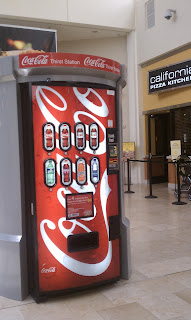Aether is an on-line publication that focuses on the emerging and converging field of geographic media. Given my interest in interactive multimedia technology and the fact that Social Science was one of my undegraduate majors, it makes sense that many of the topics covered in Aether would appeal to me. I discovered Aether about a year or so ago, and shared some information about it in the following post: Aether- The Journal of Media Geography (A Convergence of Disciplines).
Since a good number of the readers of this blog are graduate students, I decided to take the time to include in this post information and links that might be helpful to someone gathering information on a deeper level.
"Aether offers a forum that examines the geography of media, including cinema, television, the Internet, music, art, advertising, newspapers and magazines, video and animation. It is our goal to provide a space for contributions to current issues surrounding these media, beginning with constructions of space and place, cultural landscapes, society, and identity."
"We invite inquiries into the production, distribution, exhibition, and consumption of all types of media and thus we will offer critical, pedagogical and discursive content that views the world in new and exciting ways. We welcome submissions from anyone wishing to publish material that extends the boundaries of the traditional academic journal. We encourage work that is highly visual or aural, including video, and will actively promote material that makes use of our digital technologies."
I appreciate the fact that Aether's editors value the importance of using multimedia representation in scholarly research, embodied in the following quote from the introduction of Volume 3:
"All too often we remain wedded to textuality when it comes to presenting our research. However, as we move further into a world of advance capitalism driven by new information technologies and spaces of flow, streams of innovations, knowledge and ideas are increasingly circulated in non-textual formats. Academic geographers have long dabbled in video technology and the production of documentaries...We strongly encourage and support the use of multimedia productions in our journal and we hope we can offer an acceptable venue for those seeking to transcend (and even transgress) the knowledge-limiting restraints of traditional academic publications." - Jim Craine, Jason Dittmer, and Chris Lukinbeal, Aether, Volume Three
One of the good things about Aether is that all of the volumes can be freely downloaded from the website. For the convenience of knowledge-junkies, I've posted links to the past seven volumes, along with information/links about the editors and editorial board of Aether.
Volume Seven | Fall, 2010
Theme: Space and Sound: "Geographies of Music, Geographers Who Play Music"
http://130.166.124.2/~aether/pdf/volume_07/volume_07.pdf
Volume Six | October 2010
http://130.166.124.2/~aether/pdf/volume_06/volume_06.pdf
Theme: Locative Media
"This special issue of Aether, edited by Tristan Thielmann, explores the spatial turn in media studies and the media turn in geographical studies, providing a sketch of the subject area “geomedia” from a phenomenological perspective and the field of “media geography” from a disciplinary perspective." http://130.166.124.2/~aether/pdf/volume_05a/volume_05a.pdf
Theme: The Geography of Journalism (Edited by Mike Gasher) "This special issue of Aether brings together six papers that address news geography on a range of scales. Each speaks to the question of how the news media position the people and places that constitute their particular communities."
http://130.166.124.2/~aether/pdf/volume_04/volume_04.pdf
"One of the main reasons Aether was developed as an ejournal was to offer authors alternative publishing outlets– something that went beyond the textural format of both traditional hard journals and text-based ejournals. Volume Three presents the first articles that justify these editorial goals."
http://130.166.124.2/~aether/pdf/volume_03/volume_03.pdf
Theme: Imagining Geography Through Interactive Media
"This special issue of Aether offers an examination of the utopian and dystopian representations of digital landscapes including narratives of colonialism, gaming as social space and the influence of historical ideologies on social game space plus much more."
Volume One | November, 2007
"The premiere issue of Aether consists of a series of short essays by members of the editorial board. Each explores the author's personal interests in Media Geography and discusses the future direction of the field."
http://130.166.124.2/~aether/pdf/volume_01/volume_01.pdf
Aether's "Who's Who"
Review Editor
Giorgio Hadi Curti
San Diego State University
cedarboot@gmail.com
Editors
Jim Craine
California State University, Northridge
Jason Dittmer
University College London
Chris Lukinbeal
The University of Arizona
Contributors
Shawna Dark, Director
Center for Geographical Studies
California State University, Northridge
David Deis
Staff Cartographer
California State University, Northridge
Editorial Board
Paul C. Adams • University of Texas at Austin
Christina Dando • University of Nebraska, Omaha
Colin R. Gardner • University of California, Santa Barbara
Ken Hillis • The University of North Carolina at Chapel Hill
Sarah F. Ives • Stanford University
Ed Jackiewicz • California State University, Northridge
John Paul Jones III • University of Arizona
Christina Kennedy • Northern Arizona University
Susan Mains • University of the West Indies, Mona
Kevin McHugh • Arizona State University
Christopher M. Moreno • San Diego State University
Wolfgang Natter • Virginia Polytechnic Institute
Joseph Palis • University of the Philippines
Brent J. Piepergerdes • University of Kansas
Rob Shields • University of Alberta
Amy Siciliano • University of Wisconsin
Paul F. Starrs • University of Reno, Nevada
Dan Sutko • North Carolina State University
Jonathan Taylor • California State University, Fullerton
Leo Zonn • University of Texas
Aether's "Special Thanks"
Stella Theodoulou, Dean • The College of Social & Behavioral Sciences
California State University, Northridge
California State University, Northridge
